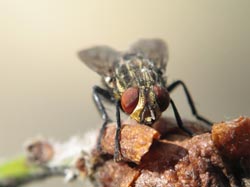Linking genes to function
Understanding 'what a gene does' essentially requires a series of functional genomics studies, which aim to link function to gene products. In terms of human genetics, these studies are made possible through the use of model organisms such as Drosophila, the common fruit fly. The EC-funded FLYSNP project set out to construct a genome-wide map of single nucleotide polymorphisms (SNPs) in the Drosophila genome, to aid the mapping of mutations. Mutation maps lead to the understanding of gene function through examination of the mutant phenotype. Project partner, the Institute of Molecular Biotechnology of the Austrian Academy of Sciences, focused on the creation of chromosomes carrying specific genetic inserts, designated EP. These EP elements were used for the study and mapping of specific mutations in the Drosophila populations. The success of the dual EP insertions was verified using PCR (polymerase chain reaction) technique. Also. phenotypic differences (eye colour change) were used as the distinguishing feature of adult specimens carrying one or two insertions. The creation of these cell lines aided the functional genomic study of Drosophila and the lines are available for further studies.







